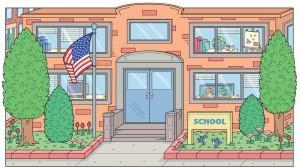As a habitat for germs, a school is not that different from any other location on our germ-filled planet.
Bacteria and viruses are always with us, and we literally couldn’t live without them. In fact, there are 10 times as many microbes in a healthy human body as there are actual human cells, and many of those microbes play critical roles in our survival.
Of course, not all germs are benevolent and schools, though they may be no more crowded with germs than offices or homes, are excellent environments for the transmission of all sorts of germs from person to person.
Children are particularly good at passing germs among themselves. They share paper and scissors in the classroom. They might share a drink at lunch. At recess, they do a lot of touching. To make matters worse, they are not very good at keeping themselves clean, and, even if they could be counted on to wash, they don’t always have easy access to soap and water.
According to the Centers for Disease Control, the primary means of transmission is by sneezing and coughing, when infected droplets spread through the air and reach the noses and mouths of people nearby. Those droplets can also reach other surfaces, and infection can be spread to someone who touches an infected surface and then touches his eyes, nose or mouth. According to the CDC, some of those infectious agents can live for two hours or more after they land.
It follows, then, that avoiding germs at school depends on the behavior of people in two different situations.
On one hand, there are the children who are already ill, including those who have not yet begun to develop a full range of symptoms. The CDC recommends that those children cover their coughs and sneezes, preferably with a tissue, and wash their hands after every cough or sneeze. If tissues are not available, coughing or sneezing into the crook of the elbow is a better option than using the hands.
No one can guaranty that those practices will always be followed, so children who are in the vicinity of sneezing classmates may have to take some of their own precautions. For them, the two most important steps are washing hands frequently and trying not to touch their own eyes, noses and mouths after they have touched a potentially infected surface.
When children remember to use them, soap and water are effective against germs, but a quick rinse is not enough. It is important to spend enough time washing. Many authorities recommend the “Happy Birthday” method: Wash your hands for the amount of time it takes to sing the one song all kids know, “Happy Birthday to You,” two times from beginning to end.
When children do not have the option of soap and water, gel and alcohol-based sanitizers kill germs just as well.
School bathrooms have more than their share of germs, but at least they are equipped with sinks that kids can use. Even so, children should learn to avoid touching surfaces like doorknobs and taps when possible, and to use a paper towel when touch is unavoidable.
In the end, there is no magic bullet.
Germs are everywhere, but children can take some simple steps to minimize, if not eliminate, the chance of coming down with a miserable cold or flu.
Sources:
This guest post is by Staci Marks, an earlier contributor to this site. Ms. Marks has a passion for health, fitness and exercise, which has led her to pursue a career in writing. She works as a part-time health-care writer at www.healthinsurancequotes.org/articles/
http://www.scientificamerican.com/article.cfm?id=human-microbiome-change
www.webmd.com/parenting/d2n-stopping-germs-12/germs-at-school?


